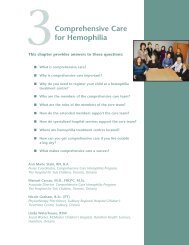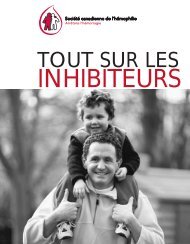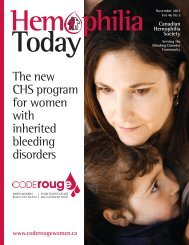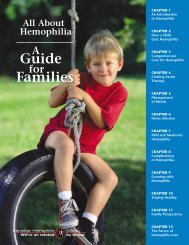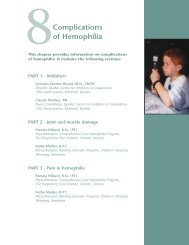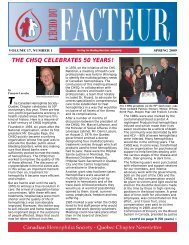Download
Download
Download
- No tags were found...
Create successful ePaper yourself
Turn your PDF publications into a flip-book with our unique Google optimized e-Paper software.
lood factorHEMOPHILIA TODAY SUMMER 2002 21THEBLOODFACTORRecovery in Factor IXConcentratesWilma McClure, R.N.,Hemophilia B (Factor IX deficiencyhemophilia) is estimated to affect 1 in30,000 males. It is caused by a geneticdefect of the X chromosome resulting in low orabsent Factor IX coagulant activity.Clotting factor concentrates have beenavailable for 30 years for the effective control ofbleeding episodes in people with Hemophilia B.In the mid and late 1980s, viral inactivationtechniques were developed to eliminate bloodbornepathogens like HIV and Hepatitis C. Thenin the early 1990s, high-purity factor plasmaderivedIX (pdFIX) concentrates wereintroduced. They included Immunine®,manufactured by Baxter; Mononine®,manufactured by Aventis-Behring; andAlphaNine®, manufactured by Alpha. Theseproducts significantly lowered the risk offormation of unwanted blood clots. Then, fouryears ago, the first, and so far only, recombinantfactor IX product (rFIX), BeneFIX®,manufactured by Wyeth-Ayerst, was approved foruse in Canada.Inhibitor antibodies to any of the plasmaderivedor recombinant concentrates continue tobe uncommon in hemophilia B, affectingapproximately 3% of patients. There have beenno incidents of viral infection with HIV or HCVin pdFIX concentrates since the late 1980s;however, since rFIX was licensed in Canada in1998, most patients have changed to this productdue to its freedom of risk of blood-bornepathogens.Global experience suggests that both the rFIXand pdFIX formulations are associated with ahigh degree of safety and predictable benefits.The most important difference betweenpdFIX and rFIX is the variable pharmacokinetics.It now appears that recovery for all FIXconcentrates is influenced by patient age andbody weight. “Recovery” is often described as “theamount of clotting factor a person’s body canactually use compared to the amount infused.”David Page,CHS Blood Safety CoordinatorIn this issue, THE BLOOD FACTOR presents three articles. The first is by WilmaMcClure, Nurse Coordinator at the Northern Alberta Hemophilia Centre, onissues related to recovery in factor IX concentrates. On page 22, I report on theFifth Workshop on Gene Therapies, organized by the National HemophiliaFoundation in April. Finally, on page 23, James Kreppner, Chair of the CHS BloodSafety Committee, writes on a variety of subjects discussed at the CanadianBlood Services National Liaison Committee.Recovery is lower in children, especially youngchildren with low body weight, for all FIXconcentrates. However, in addition, averagerecovery with rFIX is approximately 25% lowerthan with pdFIX. Thus, the effect of lower overallFIX recovery in children combined with the loweraverage recovery of rFIX for the group as a wholecan dramatically affect the amount of rFIX that iseffectively infused.As a condition for making rFIX available inCanada in 1998, the Canadian Blood Agencyrequired that hemophilia clinics conduct a postlicensure surveillance study. This was coordinatedby the Factor IX Subcommittee of the Associationof Hemophilia Clinic Directors of Canada(AHCDC). They investigated the recovery of rFIXcompared to that of the last dose of pdFIX givenbefore switching to rFIX.As stated above, the recovery of rFIX followinginfusion is significantly lower than that withpdFIX and, for all products, recovery issignificantly lower in people less than 15 years ofage compared to people more than 15 years of age.Based on this data, the mean multiplicationfactor for rFIX dose calculation to compensate forlower recovery is:• 1.29 (1.24 – 1.35) for all age groups• 1.57 (1.48 – 1.66) for patients less than 15years of age and• 1.19 (1.13 – 1.26) for patients greater than 15years of age.This means that an average person less than 15years of age would have to infuse 1.57 times thenormal dose of rFIX to recover the same amountas indicated on the box.According to Dr. Man-Chiu Poon of theAHCDC, the individual variation in recovery thatwas documented following the infusion of pdFIXand rFIX suggests that an in vivo recovery studyshould be performed on all patients receiving anew factor IX concentrate to allow more accuratedosage calculation and achieve desired clottingfactor levels. According to Dr. Poon, these shouldbe performed periodically to allow dosageadjustment, particularly in young children. Thenew BeneFIX label reinforces this.In late 2001, as a result of this new data onrecovery, Health Canada approved Wyeth-Ayerst’sproposed changes to the label for BeneFIX.The dosage calculation for pdFIX is:• Number of pdFIX units required = bodyweight(kg) x % (desired level of FIX) x 1• Example:1,800 units = 60 kg x 30% (desiredlevel of FIX) x 1The dosage calculation for rFIX as nowrecommended by Wyeth-Ayerst Canada Inc. is asfollows:Adult patients (more than 15 years of age):• Number of rFIX units required = bodyweight(kg) x % (desired level of FIX ) x 1.2• Example: 2,160 units = 60 kg x 30% (desiredlevel of FIX) x 1.2Pediatric patients (less than 15 years of age):• Number of rFIX units required = bodyweight(kg) x % (desired level of FIX ) x 1.4• Example: 840 units = 20 kilo x 30% (desiredlevel of FIX) x 1.4In summary of the data provided by theproduct manufacturer of BeneFIX, Wyeth-AyerstCanada, there have been 25 reports of allergicreactions since the product was released. Twenty ofthese were mild to moderate, involvingdermatologic or respiratory reactions. The otherfive were anaphylactic type reactions reinforcingthe need for ANA kits or Epipens for patients onhome infusion; some of the five were associatedwith formation of inhibitor antibodies. In the fouryears that rFIX has been available, there have beensix new reports of inhibitor antibodies. Thisincidence is similar to that reported with pdFIX.There were 17 case reports of red blood cellagglutination observed in approximately 4,500patients exposed to rFIX. This has been associatedwith the practice of drawing blood back into thetubing or syringe containing rFIX. A warningagainst this practice is now included in thelabeling.Over the last decade, there have been majoradvances in the treatment of Hemophilia B. BothpdFIX and rFIX are highly effective if proper doseadjustments are used. rFIX has become thestandard of care at most institutions; however, anumber of patients have preferred to remain onpdFIX, stating that they felt comfortable with theproduct they had been using for many years.Others, after using rFIX, and even though doseadjustments to rFIX were made, did not feel thatbleed resolution was as effective, and switchedback to pdFIX.Further studies will have to be undertaken todetermine whether these anecdotal reports oflesser efficacy with rFIX have a basis in fact. In themeantime, it is essential that Hemophilia Bpatients, especially children, undergo recoverystudies when starting use of a new clotting factorproduct.Wilma McClure is Nurse Coordinator at theNorthern Alberta Hemophilia Centre in Edmontonand is a member of the CHS Blood SafetyCommittee.



